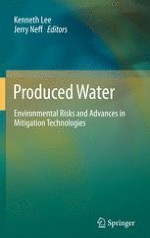2011 | OriginalPaper | Buchkapitel
27. Application of Quantitative Risk Assessment in Produced Water Management – the Environmental Impact Factor (EIF)
Aktivieren Sie unsere intelligente Suche, um passende Fachinhalte oder Patente zu finden.
Wählen Sie Textabschnitte aus um mit Künstlicher Intelligenz passenden Patente zu finden. powered by
Markieren Sie Textabschnitte, um KI-gestützt weitere passende Inhalte zu finden. powered by
